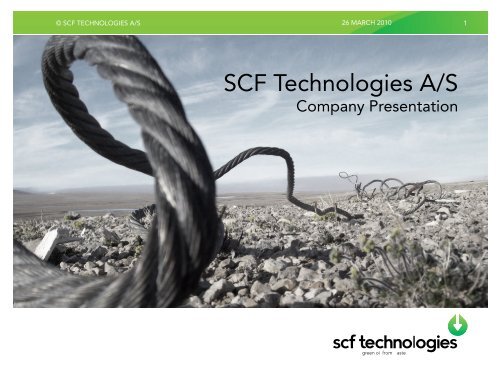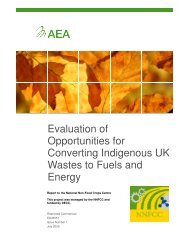SCF Technologies A/S
SCF Technologies A/S
SCF Technologies A/S
You also want an ePaper? Increase the reach of your titles
YUMPU automatically turns print PDFs into web optimized ePapers that Google loves.
© <strong>SCF</strong> TECHNOLOGIES A/S26 MARCH 20101<strong>SCF</strong> <strong>Technologies</strong> A/SCompany Presentation
© <strong>SCF</strong> TECHNOLOGIES A/S 26 MARCH 20102Energy and transportation fuel from wet waste- CatLiq ® enables the local green sustainable oil well- Very high energy balances and water export versus alternatives
© <strong>SCF</strong> TECHNOLOGIES A/S26 MARCH 20103Company History- Track-record of industrial deployment of super-critical processes2003 2004 2005 2006 2007 2008 2009 2010Industrial scalesuper critical plantfor the preservation of woodIndustrial scalesuper critical plantfor cleaning of cork closuresDevelopment project forcontainerised super criticalCatLiq plant initiated. Plantapproved by authorities in 2009
© <strong>SCF</strong> TECHNOLOGIES A/S26 MARCH 20104<strong>SCF</strong> Facilities in Copenhagen• Offices and large pilot plantin Copenhagen, Denmark• More than 2,000 hours ofoperation in pilot plant onmore than 10 differentfeedstocks – mixed and pureThe LabDemo Plant
© <strong>SCF</strong> TECHNOLOGIES A/S26 MARCH 20105CatLiq ® Conversion Process: Oil characteristics• Wet materials containing organic fractions arerapidly converted in a thermo catalytic processinto a crude oil substitute• High energy conversion rate – 70%+• Low CO 2 footprint – 50-80% reduction• Oil can be stored for long periods• Oil has low oxygen and sulphur contents• Heating value: 34-36 MJ/l (similar to crude oil)Oil may be co-fired with coal in power stationsAlso can be directly introduced into petroleumrefineries to create an automatic bio-fuelcomponent
© <strong>SCF</strong> TECHNOLOGIES A/S 26 MARCH 20106Production of Liquid Biofuel From WasteCatLiq ® plantAqueousbiomassor organicwasteRaw productBio oilGas (low CV)Ash/mineral(e.g. phosphorous)Effluent waterCatalytic ReactorSeparationRaw product Bio oil Ash/Mineral
© <strong>SCF</strong> TECHNOLOGIES A/S26 MARCH 20107CatLiq ® : High Feedstock Flexibility• Residues from ethanol and bio-diesel production such asbagasse and WDGS• Sludge from waste water treatment• Algae• Lignite (“brown coal”)• Residues from food processing• Manure from livestock production• Green household waste (or RDF)Feeds may be mixed
© <strong>SCF</strong> TECHNOLOGIES A/S26 MARCH 20108CatLiq ® Conversion Process: Key features• The organic solids are liquefied, oxygen removed and moleculessplit and rearranged, resulting in a liquid fuel with high energy density• The catalytic process operates at near-critical conditions of water atapprox. 350 0 C and 250 bars (conditions common to the oil industry)- strong sterilisation effect• The residence time in the reactionzone is relatively short (approx. 30 min.)- small process footprint• The plant may be manufactured inmodules
© <strong>SCF</strong> TECHNOLOGIES A/S 26 MARCH 20109Competitive Landscape: Unique SolutionInputOutputWetDryOtherCompost (soil)Biogas (gas)Incineration (steam)Hydro thermal process (char)1st and 2nd generation ethanolGasification (gas)Combustion (steam)OilCatLiq ®Fast pyrolysisBTL - Fischer TropschTransesterificationCatLiq ® is a thermal process which almost uniquely has a high feed flexibility(many different inputs may be used either separately or in a mix)Water is not evaporated but used actively in the process
© <strong>SCF</strong> TECHNOLOGIES A/S 26 MARCH 201010Target markets: OverviewMarketsEnergy utilitiesCharacteristicsRenewable power mandates andCO 2 concernsDesirable to leverage existinginfrastructure (e.g. cleaner coal)DriversIncrease production of green heat and powerSupplement bio-mass combustion to increase flexibilityProduce green power in turbines and generatorsSynergies with existing combustion plantsSupplement to irregular energy sources like wind andsolarTransportation fuelWaste management- Waste water treatment (sludge)- Industrial waste & residuesInternational mandates and othermechansims to encourage bio-fuelblending and reduce CO 2 in supplychainWaste water treatment facilities thatgenerate sludge. Incinerationinefficient and problematic (low gradesteam, WID compliance etc.)Industrial companies including farmers,food processing and 1 st generationethanol and bio-diesel players seekingto improve sustainability and add valueto co-products and waste streamsWaste management groups seeking tomonetise waste streamsProduce fuels with a green component at lowestpossible costMinimise disposal costs and/or establish additionalrevenue streamsEfficient solution for wet waste streamsPotential synergies with existing plantsMaximise resource utilisationNo residual wastes
© <strong>SCF</strong> TECHNOLOGIES A/S MARCH 26 201011Co-located CatLiq ® plantThere are significant synergies and benefits by co-locating and integrating CatLiq ® plants with utilityplants at existing sites Reduced overall energy consumption: CatLiq ® heat requirement can be suppliedby low pressure and low value steam fromturbine Excess heat from CatLiq ® may be used topre-heat boiler water CatLiq ® gas may be fed to the boiler forcombustion Optimal management of residues: Extracted water can be used as make-upwater in FGD system Mineral product can be sold off or mixedwith power plant fly ash Reduced opex and capex: Shared manpower reduces opex Sharing of control room and otherfacilities reduces opex Availability on-site of all utilities prior toconstruction reduces capex
© <strong>SCF</strong> TECHNOLOGIES A/S 26 MARCH 201012Waste-water treatment: Superior solution for sludgeSludge disposal today• Today the primary routes for sludge disposal include anaerobic digestion for sludgereduction, landfill, distribution on farm land and incineration• Existing solutions carry disposal costs of EUR 150-500 per dry tonne of sludge dependingon ITS composition, the disposal technique and government regulations• Incineration though less energy efficient is gaining momentum in some areas due toconcerns on heavy metals, hormones and medicine residuesCatLiq superior to incineration• Lower CapEx and OpEx reduces disposalcost to EUR 100 – 200 using CatLiqinstead of EUR 400-500 using incineration• CatLiq process produces oil which isflexible in time and place since it may bestored and transported while theincineration process (e.g. fluid bed)produces heat
© <strong>SCF</strong> TECHNOLOGIES A/S 26 MARCH 201013Conclusion: CatLiq ® is a robust, economic solution- Energy, Waste and WaterGlobal concernsCatLiq ®- Renewable energy production- Intelligent waste management- Water conservationEnergyWasteWater








